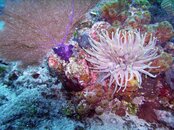firstdive2005
Contributor
I would like to apologize to Sealife cameras.
Trying the camera in the pool was a waste of time to understand how great it is.
The DC800 is a FANTASTIC camera even an photography challenged person (me) can use.
I went to Puget Sound today and took my first pictures "in the wild" and they are better then I could imagine. What will they look like when I figure it out -- I can't wait.
No strobes just a camera and a fairly new diver.
Thanks Sealife!
My sentiments also.
I do have some great shots, as Dandy Don has exposed they are fluke or lucky pics.
Dandy if you read my earlier post, we Canadians sometimes call manauls instructions. So yes Ive read them, maybe I dont understand them. I do point my strobes away. As the manauls state, as well as the tons of photo help Ive read on line state to do. I have never put any pics through photoshop, I dont know how to do that. I suppose I need to take some lessons to do that also. I need some one on one to figure it out.
So Sealife I am so very happy with what I have done when I dont know what I'm doing. Last night my wife and I had dinner with friends, my bud somehow hooked my laptop to his tv and we had a blast looking at what I had. They looked great on the screen, he even said to 'shop' them. So I will learn. thanks, this thread is very encouraging.





